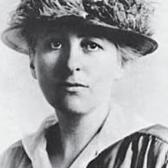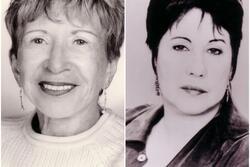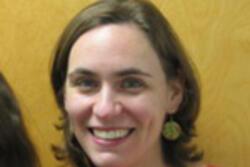The Organizers and Researchers of the Labor Movement
This Women’s History Month, the Jewish Women’s Archive is celebrating the thousands of Jewish women who have participated in activism and resistance in the United States. We all know the names of the most famous women who shaped these movements, from Gloria Steinem to Emma Goldman: the women with the megaphones, with the loud voices and stirring speeches, the women whose names made it into the history books. But one person alone can never make a movement. This month, we’re celebrating the women behind the scenes: the academics, the researchers, the women who posted bail and drove getaway cars for their more famous friends. These behind-the-scenes resistors are not as well-known, but their stories and legacies are no less important than those of the frontline women we all love. Find out more about the project. We hope that by sharing these resistors’ stories and contributions, we will demonstrate that you don’t need the loudest voice or the most extroverted personality to effect change. And we hope to inspire you to bring your own skills to the causes most important to you in 2017.
During the second half of the nineteenth century, the world saw its first large-scale industrial boom, and with it came all the attendant ethical issues that we associate with the Industrial Revolution: long hours, dangerous conditions, back-breaking work, and meager pay. In America in the early 1900s, the law was designed to protect business owners; what happened on their property was their business. Consequently, they were allowed to treat their human workers like machines, giving no breaks, no ventilation, and no sunlight.
Male factory workers combated these injustices by forming unions, but most excluded women from these conversations: women were perceived as un-organizable, weaker, and unfit for the violence of strikes. This disregard for women as laborers meant that the benefits demanded during strikes were designed for male laborers (with the assumption that they were providing for families). Women workers were stuck: there was no cohesive platform where women could demand equal pay for equal work, there was no law to protect them from factory owners and abuses of power, and there was no one to intercede on their behalf with male union leaders. Even though young women made up a majority of the garment industry’s workforce (and still do on a global scale), their voices were lost within the din of industry, entrenched sexism, and an indifferent legal system.
Enter Clara Lemlich Shavelson.
Shavelson was born in Ukraine and discovered a love of dissent through reading socialist books. When she came to America in 1905, at the age of seventeen, she found work in the Garment District. Already well-versed in socialist thought and revolution, Shavelson worked to include women’s voices in unions, insisting that, without the support of women workers, the labor movement would stagnate.
Known as a farbrente Yidishe meydlekh (fiery Jewish girls), Shavelson insisted on addressing the plight of the young female factory worker during a strike meeting at New York’s Cooper Union in 1909 and called for a general strike. Shortly thereafter, young women––whom male union leaders had discounted––rose up in overwhelming numbers, ultimately leading to the “Uprising of 20,000,” the largest strike in labor history. Shavelson’s tenacity and bravery called forth a legion of women who worked together to make their voices unified and audible.
While Shavelson took center stage as the labor movement’s pivotal female figurehead, Pauline Newman was at work in the background, bringing women together through her love of social justice and Victorian literature. Without Newman’s efforts to unite working-class women, women might not have shown up when Shavelson sounded the rallying cry.
Newman loved books and learning, even though she was actively barred from formal education. Turned away from the local school in Kovno, Lithuania for being Jewish and poor, Newman pleaded with her local rabbi until he allowed her to attend Sunday school, where she learned Yiddish and Hebrew. After her father’s death, her mother immigrated to America in 1901 with Newman and her two sisters. Newman started working at a hairbrush factory at the age of nine before taking a job at the Triangle Shirtwaist Factory. Her education was comprised of the Jewish Daily Forward and the Socialist Literary Society, where she fell in love with Charles Dickens’ socially conscious literature, and saw the working conditions in 1900s American cities clearly reflected in those of the mid-century Victorian factories.
Another one of those “fiery Jewish girls,” Newman was known for her cropped hair and tweed jackets. She was capable of moving across social divides to connect with a variety of people, smoking cigars with male union leaders and having tea with society ladies interested in learning about factory conditions. Newman straddled many divides, but her focus was always on improving working conditions for her fellow women factory workers. Her work became even more meaningful after the catastrophic Triangle Shirtwaist Fire in 1911, when the need for labor reform became painfully clear.
During a tumultuous decade, Pauline was able to emerge as an organizer, capable of sparking dialogue and reaching across class lines to bring attention to inhumane working conditions. Newman and Shavelson knew that these conditions were commonplace and that the only way to protect the worker was to call for far-reaching labor reform.
To make this kind of revolutionary reform a reality, the women of the labor movement needed facts and data. They needed the Goldmark sisters.
Pauline and Josephine Goldmark were the ninth and tenth children of well-to-do Polish immigrants. Once they graduated from Bryn Mawr, the Goldmark sisters began working with the National Consumer League, which urged shoppers to buy ethically made clothing. The sisters accumulated huge amounts of data (think Upton Sinclair's The Jungle , but with less meat) and became foremothers of the fields of social work and sociology. They embarked on a massive fact-finding mission to document the realities of factory conditions and the treatment of workers, going into the factories and interviewing the women who were fomenting the revolution from within. History is a two-part process; you need people to make it, and you need people to record it. The Goldmark sisters recorded the history that Shavelson, Newman, and their league of fiery women were making as working-class women asserted their right to safe and humane working conditions.
The Goldmark sisters’ research resulted in the famous “Brandeis Briefs,” created in partnership with their brother-in-law, Louis Brandeis. Brandeis commented that the “Brandeis Briefs” were three pages of law and a hundred pages of facts. The Goldmark sisters (along with reformers Lillian Wald and Florence Kelley) compiled these revolutionary pages in less than two weeks, publishing a powerful public indictment of factory owners and working conditions in the United States. Their evidence led to landmark labor case Muller v. Oregon (1908), which upheld a 10-hour work day; the decision declared that the state had a right (and obligation) to protect citizens in the workplace.
We need women within the factory, like Pauline Newman, who can create a cohesive group identity and function as an ambassador to the outside world. We also need women like the Goldmark sisters, who work outside the factory, sharing the stories of working-class women and their daily realities with a general public. Without these women, we would not have laws regulating child labor, the legal length of the work day, minimum wage, and working conditions.
Interested in continuing the legacy of women like Clara Lemlich, Pauline Newman, and the Goldmark sisters? There is still much work to be done.











Why people still make use of to read news papers when in this technological world all is
existing on web?
My webpage; buy twitter retweets